RAILWAYS OF BRITAIN - 37
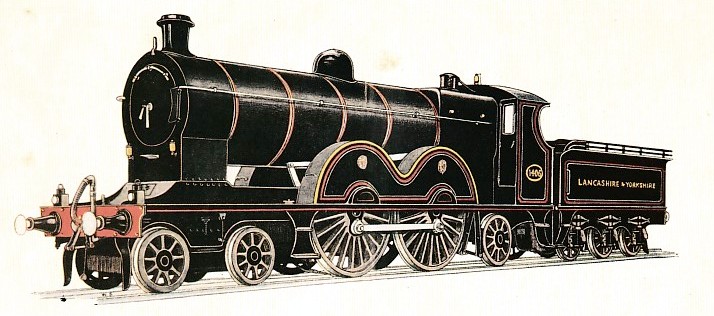
LANCASHIRE & YORKSHIRE RAILWAY EXPRESS PASSENGER LOCOMOTIVE, No. 1406
DESIGNED BY Mr JOHN A. F. ASPINALL, M.INST,C.E.
A GUARD in scarlet coat and tall beaver hat who starts the train with a tantara on a long coach-horn may seem rather out of place on a British railway, but it was with guards thus attired and equipped that the Lancashire & Yorkshire began.
On the 1st of March 1841 there opened the Manchester & Leeds from Manchester to Normanton, the nucleus of that entanglement of tracks extending from the Humber to Morecambe Bay which now occupies sixty pages of Bradshaw with its time-tables. There was bunting overhead; the engine was decorated. “At a few minutes before 9.15 a.m.”, we read, “the clanging of the ponderous bell, which at this station is suspended in the roof, gave the signal for the carriage doors to be closed, or rather slammed. All being clear, the fanfare of the guard from aloft was quickly responded to by a piercing whistle amid the roaring steam of the engine, and the train proceeded swiftly on its way to the tuneful strains of a band, which was accommodated in one of the open carriages, accompanied by the exultant cheers of the throng of spectators. At Rochdale another band of musicians waited to accompany the train with the avowed object of playing the train through the tunnel.” And, unlike other openings, all went well. “The average speed maintained to Normanton, exclusive of stoppages” - to evoke more cheering - “was at the rate of 30 miles per hour”.
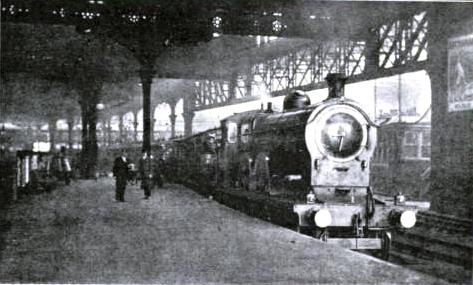
VICTORIA STATION, MANCHESTER.
No wonder the people cheered, for they had been talking about this particular railway for sixteen years; never was there a line with better prospects of success. There was no difficulty about the choice of route, there was only one easy way through the boundary hills between the two counties, and it was agreed from the beginning, in 1825, that the line must go through the Calder valley; but it was not easy to raise the money. The Liverpool & Manchester, however, put heart into the scheme, and after six years the Manchester & Leeds Company was formed to introduce Bills that failed, through the opposition of the canal interests, in both 1831 and 1832. Then came what may be best described as three years of shifting and squaring, and then the obtaining of the Act in 1836 for a railway through some of the most populous districts in England. Look at the map and think of the people and goods waiting to be carried in and about that belt of towns.
Its engineer was George Stephenson, and among those who helped him was Alexander Nimmo, F.R.S., who was also engaged on the Manchester, Bolton, & Bury, now also part of the Lancashire & Yorkshire. A great man was Nimmo, an engineer who did much in Ireland and elsewhere and knew more than most men, though now nearly forgotten. He was one of Stephenson’s supporters before the Commons Committee on the Liverpool & Manchester Bill. “Sir”, he was asked, with regard to Chat Moss, “would you undertake to float a railway over a morass?” “Yes, sir”, said Nimmo cheerily, “and I will undertake to float one over the sea, if you will find the money for it!”
The works began on the 18th of August 1837. The ground was hilly and the rocks were hard, and people who knew nothing about engineering, among whom were most of the newspaper men, kept up a continuous chorus as to the impossibility of the endeavour. But Stephenson went steadily on with his easy gradients through magnesian limestone, coal measures and millstone grit, yoredales, and then millstone grit and carboniferous again, “cutting through them like cheese” - very hard cheese, with occasionally a soft patch of clay or shale where it was not wanted. Littleborough, 2885 yards long, was the most difficult tunnel made up to then. It was longer than Kilsby, and more than a thousand men were at work in it for four years. Thirteen stationary engines were engaged in hauling the stuff out of it, and 23,000,000 bricks and 8000 tons of Roman cement were used in its lining.
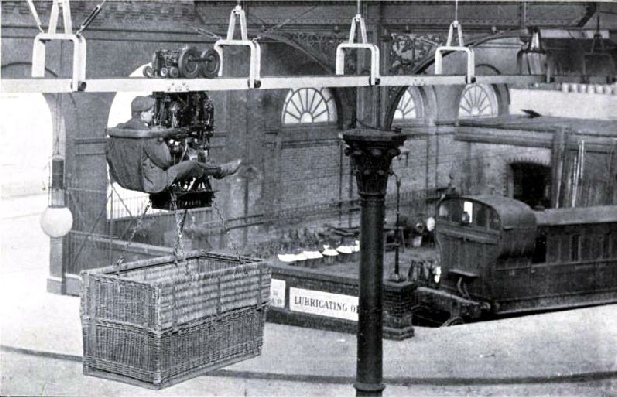
AN OVERHEAD CARRIER: A NOVEL DEVICE FOR TRANSPORTING LUGGAGE AT VICTORIA STATION, MANCHESTER
Beyond the great tunnel, the cutting had to be piled to obtain a firm foundation; then came the short Winterbutlee tunnel, and the viaduct of eighteen arches leading on to the skew-bridge over the Rochdale canal to Todmorden on the county boundary, where the nine-arched viaduct carries the line 50 ft. and more above the old road. Two more short tunnels followed, and another viaduct leading to another tunnel, and at Charlestown there would have been another tunnel had it not been found better worth while to run the line in curves round the hill, thus setting the fashion so largely followed abroad. River, road, and canal were then crossed, and, through another short tunnel, Hebden Bridge was reached. Sowerby Bridge was similarly reached through another tunnel, and soon afterwards the numerous crossings of the Calder began. Passing Horbury, the Calder was diverted to save two bridges, and, passing Wakefield, the river was crossed for the last time, and the route was clear to the junction with the North Midland near Normanton after engineering works varied enough to satisfy even a Canterbury man.
In the whole fifty miles there were not four miles that were straight. The gauge, remarkable for a Stephenson line, was 4 ft. 9-in to ease the running on the curves; and the permanent way was similar to that of the North Midland with the parallel rails held in the chairs by a ball and key. Sleepers of larch were used on the embankments, and stone blocks from the cuttings to as great an extent as possible until the mistake was acknowledged. The engines were mostly Sharps or Stephensons, and were all 6-wheelers with 14-in by 18-in cylinders, and 5 ft. 6-in driving wheels.
Provision was made for three classes of passengers, or rather four, for private carriages were carried on trucks at sixpence a mile, the people riding in them paying twopence a mile in addition. In the company’s first-class coaches the fare was threepence a mile. Second-class people at twopence a mile were in coaches painted black above and dark green below, with red panels and red bearing springs, the roof being nearly flat, the seats being unpadded. There were three compartments, the two double seats having half backs from which an iron upright supported the roof, and under the seats were lockers for dogs or luggage.
There were quarter-lights on each side of the half-door, and these were fitted with sliding shutters which, when pulled along, met over the door, a remarkable arrangement that allowed no light to pass through the side windows except when it was shut out from what would now be the window in the door. At each end of the roof was a seat for the guard, whose scarlet coat, when new, must have cried out gloriously against the black and dark green.
The wagons were merely open trucks with a handrail round them but no seats. The first great improvement was to bore holes in the floor to let the rain out, the next to run a wooden bar from end to end and another across for the passengers to cling to, the next to give them seats; then came the roof, then the sides were made up, with wooden slides for windows. “Wagon passengers” as they were called, not third class, were treated as undesirables and severely discouraged. The porters were not allowed to touch their luggage, and they had to be at the booking office at least ten minutes before the departure of the train or they would not be booked.
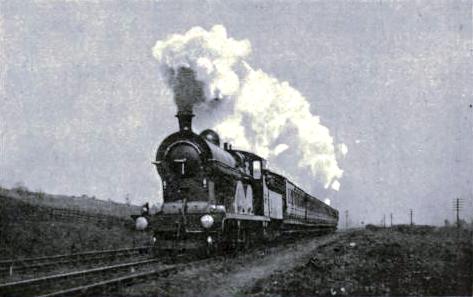
THE MANCHESTER AND BLACKPOOL EXPRESS.
As the Manchester & Leeds began with coach guards in all their latest glory, so it began, like other old railways, with coach booking on the latest principle. There was a book with counterfoils in which had to be written twice the passenger’s name, with the date, the destination, and the fare, half the leaf being torn out and given to the passenger, the counterfoil remaining as the record. The passenger’s slip when collected at the destination was stuck on a spike file, and with other such vouchers went to headquarters to be compared with the books. Booking a train was a long job even at a bye-station, such a station, for instance, as Milton, now Brampton, on the Newcastle & Carlisle, where the clerk invariably sought the better way and generally found it.
At Lancaster in 1792 was born Thomas Edmonson, an enterprising child who was taught knitting by his mother to keep him out of mischief. At Lancaster, Gillow the cabinetmaker was then making chairs as the firm had been doing for years, and are still doing, and keeping working drawings of every order so classified that then, as now, you can order, say, a couple of dining-room chairs as supplied in seventeen hundred and something, and in a fortnight the chairs come along matching exactly those that have been in the family for a century or more. Edmonson was apprenticed to Gillow and trained in thoroughly genuine work. He did well; he thought and he invented machinery and some things that had a large sale, and some that had a limited one, among the latter the combination apparatus by which the busy housewife could rock the cradle and churn the butter at one operation. “In due course”, as it has been quaintly said, “ he entered into business; though a Friend he was not successful”; and like many others who failed in business he obtained a situation on a railway - and he was sent to Milton to make himself useful in many ways, including this booking, which could not have taken up much of his time.
Occasionally he took a trip eastwards, and one day as he was walking in a certain field in Northumberland he reached a spot in that field, still pointed out, where an idea occurred to him. “Why all this fumbling and spelling of passengers’ names? Why not treat them anonymously and number them? Why not a strip of paper or pasteboard printed with the names of station and class, with the fares? Why not consecutively number them for accounting purposes and date them on the day of issue to prevent fraud? Two machines could do it!” And then he thought out the machines, and went to talk it over with his friend Blaylock the watchmaker.
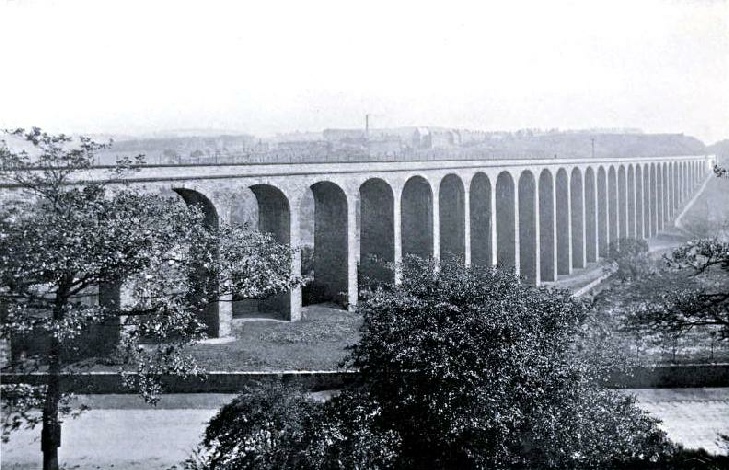
THE LOCKWOOD VIADUCT, NEAR HUDDESFIELD
They made the machines, that was not difficult; but to persuade a company to adopt the new system was another matter. The Newcastle & Carlisle would have nothing to do with it, and Edmonson tried elsewhere. He tried the Manchester & Leeds, and fortunately the manager was just in the mood to jump at it. The delay at the booking-office windows while the clerks wrote their fastest with spluttering quill pens and pencils that broke at the point had become exasperating. The “wagon passengers” were rough and noisy, and made merry over the coach-horns and jeered at the scarlet coats that had been ruined by the smuts in the tunnels owing to the guards having to sit on the tops of the carriages at all times and in all weathers; and everything appertaining to the old coaching days had become abhorrent. New methods in all things were evidently needed for the new conditions. And thus it happened that Edmonson was permitted to give his invention a trial on a section of the line on his own terms of half a sovereign per mile of road per year.
That progressive engineer Captain William Scarth Moorsom (whose name it is as well to give in full to distinguish him from his brother, Captain Constantine Richard Moorsom of the North Western) was also applied to by Edmonson, and introduced the new tickets on the Birmingham & Gloucester shortly after they had got to work on the Manchester & Leeds; and, the advantages being evident, the plan became generally adopted and spread with the railways all over the world. Edmonson’s income grew with every mile, and the surplus he invested until he had accumulated enough to pay off his old bankruptcy creditors in full; and then he started on another series of investments, all in railways, and became wealthy, as he certainly deserved to do. His younger brother George, of some note as an educationist, was also a railway-minded man, and introduced the study of Bradshaw into his famous school at Tulketh Hall, setting his pupils to work out problems in cross-routes and connections as being a better mental gymnastic than Latin or Greek.
There are over a thousand millions, that is more than five hundred acres, of tickets issued in this country during the year. They are packed in bundles of 250, and are numbered consecutively up to 9999, and then a new series begins if it does not begin before, but frequently they are not wanted in such numbers, and even only five of a sort have been printed. They are all of the same size to suit the printing machines, which print only one ticket at a time, but their colours and patterns are nearly as numerous as those of dress fabrics. The colours of the ordinary tickets of all the chief lines are given in the Railway Year Book, but these are only a fraction of the variety used. Some are used in millions, some not in tens. From one station the writer booked to a certain seaside resort soon after the branch was opened, and his ticket was 001; next year he went, and his ticket, very faded at the edge, was 002; next year the ticket, not quite so dirty, was 004. Four tickets in three years; that is the smallest number to his personal knowledge.
The tickets are placed in the tubes with the highest number on the top, there being at the bottom of the tube an opening just large enough for the lowest ticket to be drawn out. In fact it was the ticket tube that gave the hint for the automatic sweetmeat delivery stand which the ticket-printing machine somewhat resembles in shape, and this led back to the automatic ticket machine by which the Lancashire & Yorkshire sells 750,000 in a year.
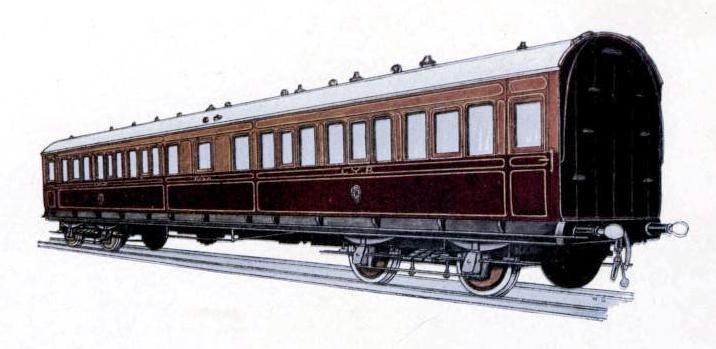
LANCASHIRE & YORKSHIRE RAILWAY THIRD-CLASS SALOON, No. 2509
The numbers of all the bottom tickets are taken before any are issued, and, as each ticket is sold the next is drawn just far enough forward to show the number. When the train has gone (or at any time that may be necessary) the numbers are taken down, and the old numbers being deducted from them give the amount and details of the sales, and consequently the cash for which the issuer is liable. This is all done in the train books, the totals of which go into the summary book to give the day’s total takings that are sent in the double-lidded boxes to the larger stations, or are paid into the bank or, at terminal stations, are collected by the bank.
Every month the starting and closing numbers of the tickets in every tube are entered in a book, a copy of which goes to the audit office; and after collection at the destination every ticket is arranged in numerical order and sent to the audit office, whence all through tickets go to the Clearing House, to be dealt with according to their nips and punch-marks. Those who know these things and appreciate them keep their tickets as undamaged as they can; the ignorant and the foolish do their best to make their tickets illegible, but, as we have said elsewhere, “with the spread of education and the increase of idiot asylums, such people become fewer, and every year there is a slight increase in the percentage of tickets returned from the collectors in good condition”.
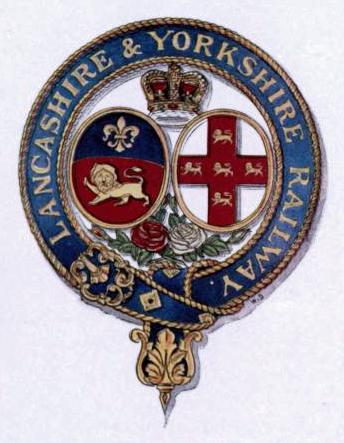 Among other novelties introduced by the Manchester & Leeds under Captain Laws was the first combined railway and steamboat long distance excursion; and, considering it was the first, it took a deal of arranging. This took place during the Whitsun holidays of 1843; the train was worked through Normanton on to the North Midland, thence on to the York & North Midland, thence on to the Hull & Selby to Hull, where the steamer took the excursionists to Leith for Edinburgh - a really remarkable effort for those early days.
Among other novelties introduced by the Manchester & Leeds under Captain Laws was the first combined railway and steamboat long distance excursion; and, considering it was the first, it took a deal of arranging. This took place during the Whitsun holidays of 1843; the train was worked through Normanton on to the North Midland, thence on to the York & North Midland, thence on to the Hull & Selby to Hull, where the steamer took the excursionists to Leith for Edinburgh - a really remarkable effort for those early days.
LANCASHIRE & YORKSHIRE RAILWAY COAT OF ARMS
The Manchester & Leeds soon changed its name. In 1847 the company assumed its title of the Lancashire & Yorkshire on the first of that series of amalgamations which, with loops and spurs, have spread it across the two counties from Goole to Fleetwood, named, by the way, by Sir Henry Fleetwood after himself, he having planned the whole place on the site of a rabbit warren in 1836, formed the harbour and brought the railway to it, making it “a seat of commerce situated advantageously for intercommunication between the great marts of England and the seaports of the Isle of Man and the north of Ireland”.
Of its extensions the best worth remembrance is that from Wigan to Southport through Burscough Bridge, which it built on compulsion. Before its opening the train took passengers to Euxton, and thence they had to make their way by coach. The Act for the continuation of the railway had been obtained for years, but, fearing it would not pay, the company did nothing, and it was not until a Southport man secured a mandamus compelling them to complete the line that they set to work on what proved to be the most profitable section of their system. The other Southport line, that from Liverpool by the coast, also proved unexpectedly profitable, and at length the traffic on it became so great that the only way to deal with it was by electrification.
One advantage was evident from the first. As Mr. John A. F. Aspinall pointed out, “Every time a locomotive train comes in and goes out you have four platform operations and eight signal operations. First of all the train comes in, then a locomotive follows it, that is two; then the train goes out, that is three; then the locomotive which brought it in goes out, that is four platform operations, which means eight signal operations. The electric motor train comes in, that is one; the motorman goes to the other end of the train, and the train goes out, that is two. You have only two platform operations, and four signal operations. The result is that, by using motorcar trains instead of locomotives, you double the capacity of your terminal accommodation”. Then there were other advantages, the quicker getting into speed and the higher journey speed, the more frequent service, the greater possible mileage of each train per day, and the increased loading and unloading capacity of the platforms. Against this were the expense of the installation and upkeep, and the unforeseen drawbacks. In short, it was a plunge, and it has proved to be a plunge that paid.
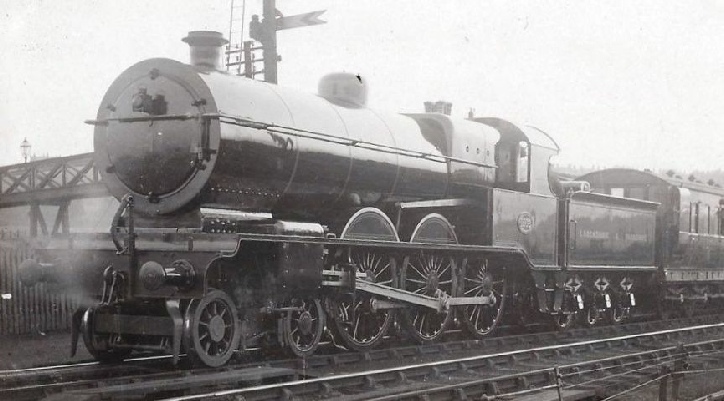
EXPRESS PASSENGER LOCOMOTIVE NO. 1508
The Southport branch has fifteen-stations on it and is 18½ miles long, and with 4 miles of four tracks, 25 miles of double track and the sidings, there are 77 miles of single track. All the four tracks were electrified, but although the frequency of the trains has been more than doubled, and the speed increased, the work is easily dealt with on the two lines of way; and the two western lines are left for steam locomotives only, for, as on the North Eastern, the mineral and merchandise traffic is worked in the old way, the passenger trains only being worked electrically.
Before the change the Liverpool & Southport line required 30 engines and 152 coaches with 5084 seats; it now has 38 motor-cars and 53 trailers, giving seating accommodation for 5814. The trains work up into speed quickly, and in half a minute after starting are travelling 30 miles an hour; expresses do the whole distance in 25 minutes, but the stopping trains, with fourteen stops, take 12 minutes longer. The Lancashire & Yorkshire has its race traffic, and the running on the Aintree branch is a good example of what the new system is capable. On Grand National Day 13,000 people leave the Exchange Station at Liverpool for the course between 11.15 a.m. and 2 p.m., and these used to be taken in special trains holding about 500 passengers each. Unlike engines, the motors, as we have noticed, require no shifting and shunting, and the result is that with trains holding a few more passengers made up of the ten old coaches with four 150 horse-power motors, for which the only addition necessary was the running of a few cables over the roofs of the coaches to complete the electrical connection of the motor-cars, the traffic is worked more easily and quickly.
There is one drawback to electrical traction. According to the present law locomotives are not rated, but power-stations are, and heavily too; consequently the site of a power-station requires consideration from one more point of view than would at first seem necessary. The power-station of the Southport line is at Formby, where are five generators, four of 1500 kilowatts and one of 750 kilowatts, and there are four rotary sub-stations and five battery sub-stations to deal with the fluctuations of the load.
The third rail, or conductor rail, stands 3-in above the track rail, as is now the general practice arrived at by the meeting at the Railway Clearing House in March 1903 in order that electrically driven rolling stock can work over other companies’ lines when required, the horizontal distance between the centre of the track and the centre of the third rail being the standard 3 ft. 11½-in. The fourth or return rail should be 1½-in above the track rail, as determined at the same meeting, but on the Southport line this rail is below the level of the track and uninsulated, the current being returned through the wheels to the track and from it by means of copper bonds to the central fourth rail to which the track rails act as auxiliaries. The rapid wearing away of the track rails and tyres is as noticeable on this as on other electrical lines, and according to Mr. Aspinall is probably due to the low centre of gravity of the motor-trucks throwing the pressure that should be borne by the tread on to the flange. At the same time it should be remembered that the ordinary permanent way, etc., on our lines, as a whole, costs on the average 15 per cent, per year for repairs, in other words wears out every seven years.
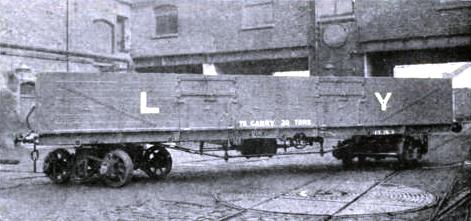
A 30-TON SWIVEL GOODS WAGON
The Lancashire & Yorkshire has over 1500 locomotives, that is more than the Great Northern, Great Central, South Western, Great Eastern, Brighton, or South Eastern & Chatham. Of these 1100 are in steam every day, and over a thousand of them have been built at Horwich. The works there are among the best in the country, and cover 116 acres, of which over twenty-two are occupied by the buildings, among them the splendid erecting shop 1520 ft. long. They were begun in 1886, and the first engine was completed in 1889.
This was Mr. Aspinall’s 8-wheeled passenger tank with a radial box at each end, a 2-4-2, the first of a class of which no less than 270 have been built, which run more than half the passenger engine miles. A class of engines that run 7½ million miles a year is worth making a note of. They haul trains of 270 tons at an average speed of 36½ miles an hour over some of the steepest grades on one of the most difficult lines in England. They carry their 1540 gallons of water in side and back tanks, and take it up when running either way by a vacuum apparatus worked from the brake, for the Lancashire & Yorkshire was the first company to follow the North Western in laying down water-troughs, and has them at about a dozen places on their complicated system of which the two busy areas communicate by the neck through the dividing range. The cylinders, inside with top valves, are 18-in by 26-in, the coupled wheels are 5 ft. 8-in, the radial wheels 3 ft. 7¾-in, the boiler is 10 ft. 7⅜-in by 4 ft. 2-in, the 220 1¾-in tubes have a heating surface of 1108·73, and the firebox one of 107·68, while the grate area is 18¾ sq. ft.
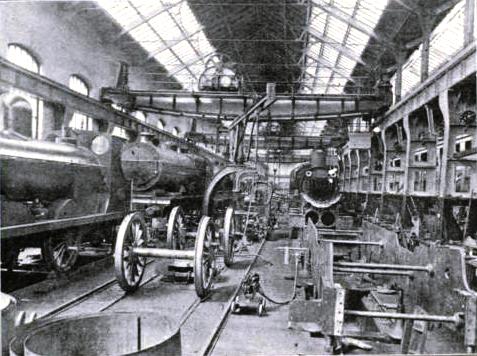
THE LOCOMOTIVE ERECTING SHOP AT HORWICH
Mr. Aspinall’s policy was to have as few classes as possible and to favour standardisation and interchangeability. The result is that there are only fifteen classes of engines, excluding pug engines and rail motors, now on the line. The second group was his 6-wheeled goods engines, of which the first of the 440 appeared in September 1889. These are hauling goods trains weighing 760 tons, and come in useful for passenger work during the excursion season. Their cylinders, wheels, tubes, and grate area are similar to those already given, but their boilers are 10 ft. 9¾-in by 4 ft. 6-in, and their total heating surface is 1193. In going-away times they have a lively freight behind them. A Lancashire operative, or rather the thousandth part of a mixture of a thousand Lancashire operatives, for there is no such individual as an average man, is proficient in humour best describable as broad and homely, and undoubtedly loud, which finds its best expression in a trip to Blackpool, the English Coney Island.
Aspinall’s 8-wheeled bogie passenger engines, 40 in number, followed these. According to Mr. Hughes, the Chief Mechanical Engineer of the line, whose excellent paper is the authority for the details of its present locomotives, “they were designed to work the fast passenger traffic between Manchester and Southport, Manchester and Liverpool, Manchester and Blackpool, and Manchester and Leeds, and have similar cylinders to the goods engines, and unbalanced valves. When designed, they had the largest coupled driving wheels in this country, namely, 7 ft. 3-in diameter. The tenders are interchangeable with those of the goods engines. The maximum loads hauled are 220 tons at an average speed of 42·8 miles per hour”.
The next class of importance is that which was introduced in October 1891, of which there are 20 hauling loads of 1000 tons on the level. These 6-wheeled coupled outside cylinder shunting tank engines have 17-in by 24-in cylinders, 4 ft. 6-in wheels, a heating surface of 1167, a grate area of 17 sq. ft., and a tank of 980 gallons. In March 1899 came the first of 20 Atlantics, the largest inside-cylindered engines of the type then built by us. The cylinders of these 4-4-2’s were 19-in by 26-in, and steam jacketed, the bogie wheels were 3 ft. 0½-in, the trailing wheels 3 ft. 7¾-in, and the coupled wheels 7 ft. 3-in; the boiler was 15 ft. long and 4 ft. 10-in in diameter, the heating surface of the 225 2-in tubes was 1767, that of the firebox being 161, and the grate area 23 sq. ft. They had Richardson valves exhausting through the back, and one of them was fitted with a superheater. Twenty more of these were built, having no jackets to the cylinders, five of them having superheaters. These forty engines are hauling trains of 375 tons, the fastest and heaviest on the line, no less than 23 trains a day between Liverpool and Manchester doing the distance, 37 miles in 40 minutes, at the rate of 55·4 miles per hour. The distances on the Lancashire & Yorkshire are not unlike those on the Brighton, the longest non-stop run being the 48 miles between Wakefield and Manchester, but the goods traffic is half a dozen times as great, and the road almost as many times as difficult, being among other things more undulating - between Shawforth and Britannia, for instance, on the Bacup and Rochdale branch, where it reaches its summit level, it rises to 965 ft.
In 1900 the first of 108 8-wheeled coupled coal engines was set to work. These have Belpaire fireboxes. Similar to these came a class of 21 in March 1903, fitted with corrugated flue boilers. The cylinders are 20-in by 26-in, the wheels are 4 ft. 6-in, the boilers are 12 ft. 9-in by 5 ft. 5¼-in, and the 280 2-in tubes have a heating surface of 1775, that of the firebox being 125, the grate area being 26. In 1899 Mr. Aspinall became general manager, and was succeeded by Mr. Hoy, who left in 1904 to be manager at Beyer’s. He built 220 engines at Horwich, among them those just mentioned, the first of which was designed by his predecessor. In 1903 he built his first 10-wheeled radial tank for working the Oldham branch, where the gradients are 1 in 41 and there are eight stations in 71 miles, thus requiring an engine that will get into speed quickly. These 2-6-2’s have 19-in by 26-in cylinders, the radial wheels being 3 ft. 7¾-in, the 6-coupled wheels 5 ft. 8-in, the 239 2-in tubes having a heating surface of 1877, and the firebox one of 168, the firegrate area being 26·05, and the tank holding 2000 gallons.
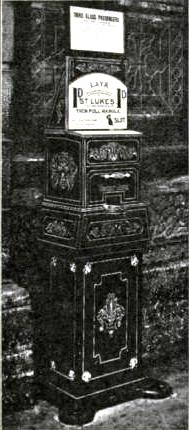
AUTOMATIC TICKET-ISSUING MACHINE
In 1904 Mr. George Hughes succeeded Mr. Hoy, and he built the thousandth engine at Horwich, a compound with four cylinders, the two high-pressures outside the frames and the two low-pressures inside. In 1905 he introduced his 8-wheeled radial tanks with Belpaire fireboxes. They are similar to the older type, but have boilers with a fifth more water and two-fifths more steam space. Six of the old round top firebox type he fitted with the Druitt-Halpin thermal storage tank, distinguished by the cylinder mounted on top of the boiler, which has proved an advantage on rising gradients though making very little difference elsewhere. In 1906 he fitted two standard goods engines with Schmidt’s superheater, replacing their 18-in cylinders by 20-in, and, this being an improvement, five passenger engines and twenty new goods engines are now working with the appliance, which weighs two tons but increases the tractive force in a greater degree than the adhesion.
In March 1908 came the first of his 10-wheeled banking engines, 0-8-2, with the largest cylinders, 21½-in by 26-in, used until then in our simple engines. The coupled wheels of these are 4 ft. 6-in, the radials 3 ft. 7⅝-in; the boiler is 13 ft. by 5 ft. 8¼-in, the heating surface of the 295 2-in tubes is 2008, that of the firebox being 190; the firegrate area is 25·6, and 2000 gallons of water are carried. In these engines a reversion to an old practice was adopted, the two inner pairs of driving wheels being without flanges and having the tyres wider than the others so as to allow of curves being more easily negotiated.
The 4-cylinder bogie passenger goods engine introduced in June 1908 will be our last example of the locomotives of the Lancashire & Yorkshire. The four cylinders of this 4-6-0 are 16-in by 26-in, the inside pair working on the leading axle, the outside pair on the second axle. The wheel base, 25 ft. 4-in, was kept short by placing the inside cylinders in advance of the bogie centre, and flexibility was obtained by giving three-sixteenths lateral play to the trailing wheels and fitting the coupling rods with ball-and-socket joints. The bogie wheels are 3 ft. 0½-in, the coupled wheels 6 ft. 3-in; the boiler measures 15 ft. by 5 ft. 8¼-in, the grate area is 27 sq. ft., there are 295 tubes of 2-in outside diameter as in the other engines, and these give a heating surface of 2317, the total heating surface being 2507 when that of the firebox is added. The engine, which weighs over 77 tons, is very steady and smooth running owing to the ingenious arrangement of balancing reciprocating parts by opposite reciprocating parts and revolving weights by revolving weights.
Horwich is approached by a branch between Bolton and Chorley. It is well in the centre of the western division, of which Hellifield is the farthest north and Liverpool the farthest south. The eastern division covers a much narrower strip of country stretching across to the Humber. On the North Eastern, by means of running powers, the L. & Y., as it is nearly always called, reaches York from Normanton, and Hull from Goole; on the Great Northern, from Askern, it reaches Doncaster; on the North Western, from Bradley Wood and Heaton Lodge, it reaches its detached territory between Huddersfield and Penistone; and on the Great Central, from Penistone, it reaches Sheffield. Manchester is its centre, and Liverpool, Fleetwood, and Goole its chief ports, though the line to Fleetwood and Blackpool, and the other stations north of Preston, it owns jointly with the North Western.
Goole was a village, where the Dutch river enters the Ouse, until 1820, when the Act was obtained authorising the canal from Knottingley ending in two docks, one of which was opened in 1825 and the other in 1826. Two years after the opening of the second dock it had thriven sufficiently to be made a Customs port, and for seventeen years it slowly grew. Then, in 1845, came the Wakefield, Pontefract, & Goole Railway and Aire & Calder Navigation Act to construct further docks, and thenceforth it increased in prosperity at a quicker pace; and now it has eight docks and sidings for four thousand wagons, and eighty goods trains go out of it a day. When the Lancashire & Yorkshire absorbed the railway it did its best to foster the trade of the canal port, and by this policy it was led on to have ships of its own. In 1905 it bought the fleet of the Goole Steam Shipping Company, and to this in the following year it added the Goole boats of the Wholesale Co-operative Society; and now it has twenty-six steamers trading between the Humber and the Continent, at Liverpool it has three trading Avith Drogheda, and at Fleetwood it is joint owner with the North Western of seven more, trading to Belfast, Londonderry, and the Isle of Man.
Meat, fish, milk, special goods trains of all kinds are now run on our railways, but every one may not have heard of butter trains. Every Sunday there comes into Goole a cargo of butter, which is unloaded and sent off in two trains at two in the morning to reach Manchester at five, and be delivered to the traders at seven. The wagons are but a few among the 32,500 owned by the company, which uses them during the year in hauling about some 7 million tons of merchandise and over 18 million tons of minerals along its 585 miles of track; and every year it carries 60 million passengers in its 4800 coaches, its passenger mileage being about 13 millions. What this means can be best appreciated by comparing it with the South Eastern & Chatham, which has a longer line by 44 miles and a passenger mileage of 12 millions. In short, the Lancashire & Yorkshire takes more money for each mile of track, and runs its engines more miles on each mile than any other of the great companies, and its coaches and wagons - some of them of 15, 20, 30 tons or more - would form a train that would reach from Liverpool to the Spurn.
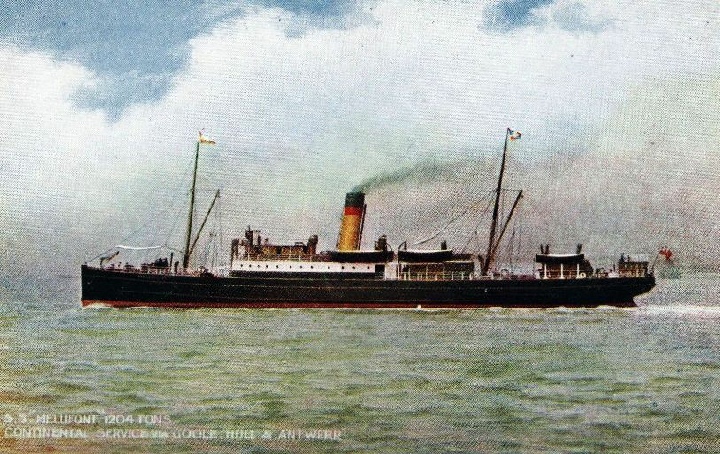
THE LANCASHIRE & YORKSHIRE RAILWAY STEAMER MELLIFONT
You can read more on “The Great Central Railway”, “The North Eastern Railway”, “Victoria Station Manchester” and “The World’s Most Famous Railway” on this website.









 Among other novelties introduced by the Manchester & Leeds under Captain Laws was the first combined railway and steamboat long distance excursion; and, considering it was the first, it took a deal of arranging. This took place during the Whitsun holidays of 1843; the train was worked through Normanton on to the North Midland, thence on to the York & North Midland, thence on to the Hull & Selby to Hull, where the steamer took the excursionists to Leith for Edinburgh -
Among other novelties introduced by the Manchester & Leeds under Captain Laws was the first combined railway and steamboat long distance excursion; and, considering it was the first, it took a deal of arranging. This took place during the Whitsun holidays of 1843; the train was worked through Normanton on to the North Midland, thence on to the York & North Midland, thence on to the Hull & Selby to Hull, where the steamer took the excursionists to Leith for Edinburgh -



